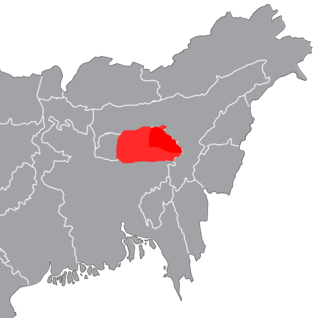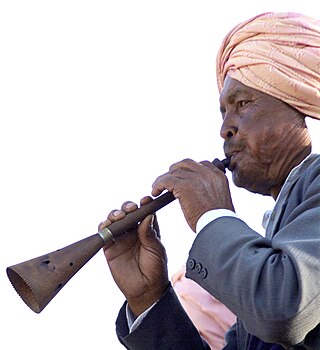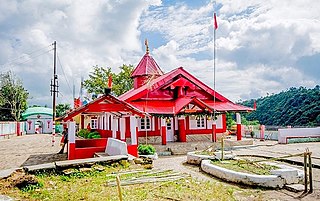
Meghalaya is a state in northeast India. Meghalaya was formed on 21 January 1972 by carving out two districts from the state of Assam: (a) the United Khasi Hills and Jaintia Hills and (b) the Garo Hills. The estimated population of Meghalaya in 2014 was 3,211,474. Meghalaya covers an area of approximately 22,429 square kilometres, with a length-to-breadth ratio of about 3:1.

Khasi is an Austroasiatic language with just over a million speakers in north-east India, primarily the Khasi people in the state of Meghalaya. It has associate official status in some districts of this state. The closest relatives of Khasi are the other languages in the Khasic group of the Shillong Plateau; these include Pnar, Lyngngam and War.

Shillong is a hill station and the capital of Meghalaya, a state in northeastern India. It is the headquarters of the East Khasi Hills district. Shillong is the 330th most populous city in India with a population of 143,229 according to the 2011 census. It is said that the rolling hills around the town reminded the British of Scotland. Hence, they would also refer to it as the "Scotland of the East".

The Khasi people are an ethnic group of Meghalaya in north-eastern India with a significant population in the bordering state of Assam, and in certain parts of Bangladesh. Khasi people form the majority of the population of the eastern part of Meghalaya, that is Khasi Hills, constituting 78.3% of the region's population, and is the state's largest community, with around 48% of the population of Meghalaya. They are among the few Austroasiatic-speaking peoples in South Asia. The Khasi tribe holds the distinction of being one of the few remaining tribes that have a matrilineal society. Under the Constitution of India, the Khasis have been granted the status of Scheduled Tribe.

The Khasi Hills are a low mountain formation on the Shillong Plateau in the Meghalaya state of India. The Khasi Hills are part of the Garo-Khasi-Jaintia range and connect with the Purvanchal Range and larger Patkai Range further east. The Khasi Hills, and the whole Garo-Khasi-Jaintia range, are in the Meghalaya subtropical forests ecoregion.
The indigenous people of Bangladesh are ethnic minorities in Chittagong Hill Tracts (southeastern), Sylhet Division (northeastern), Rajshahi Division (west), and Mymensingh Division (north-central) areas of the country. They are indigenous and the tribal races, total population of ethnic minorities in Bangladesh was estimated to be over 2 million in 2010. They are diverse ethnic communities including Tibeto-Burman, Austric and Dravidian people.

The tangmuri, ka tangmuri in the Khasi language, is a double-reed conical-bore wind-instrument used by the Hynniew Trep people of Meghalaya State in North-East India.
Evangelization of Meghalaya began in the 19th century during the British era. In the 1830s, American Baptist Foreign Missionary Society had become active in Northeast to evangelize indigenous tribes to Christianity. Later, they were offered to expand and reach into Sohra Meghalaya, but they lacked the resources to do so and declined. Welsh Presbyterian Mission took the offer and they began work at Sohra mission field. By the early 1900s, other Protestant denominations of Christianity were active in Meghalaya. The outbreak of World Wars forced the preachers to return home to Europe and America. It is during this period that Catholicism took root in Meghalaya and neighbouring region. Currently, Catholics, Presbyterians and Baptists are three most common Christian denominations found in Meghalaya.

Mawphlang is a village in the East Khasi Hills district of Meghalaya state in north-eastern India, 25 kilometers from Shillong. The word maw means "stone", maw phlang means "grassy stone," and is one of many settlements in the Khasi hills named after monoliths.

Paul Lyngdoh is an Indian politician, poet, author, songwriter and musician from Shillong, Meghalaya.

Neil Nongkynrih was an Indian concert pianist and conductor. He founded the Shillong Chamber Choir (SCC), which won the reality show India's Got Talent in 2010. He was awarded Padma Shri, the fourth highest civilian award of India in 2015.
Dkhar, is a term used by the Khasis to refer to non-Khasi people in Meghalaya. It is non derogatory but some perceived it as derogatory. For Khasis any non-tribal is a dkhar and they address them by that term. Sometimes the word dkhar have been collectively used with the term heathen (Non-believers), as most of the native Khasis are christian, While non-tribals are mainly hindu. In real, the term is mostly used against affluent Bengali Hindu settlers from West Bengal or the Bengali Hindu refugees from erstwhile East Pakistan It is sometimes abbreviated to ′Khar and may also denote a Khasi clan with the same name.
R. P. Diengdoh, AC was an Indian police officer with the Meghalaya Police who was posthumously awarded India's highest peace time gallantry award Ashoka Chakra.

Northeast India consists of the eight states Arunachal Pradesh, Assam, Manipur, Meghalaya, Mizoram, Nagaland, Sikkim and Tripura. Tourism in this area is based around the unique Himalayan landscape and culture distinct from the rest of India.
Hamlet Bareh Ngapkynta (1931-2012) was an Indian writer, historian and film director from the Northeast Indian state of Meghalaya. He is known as the first person from the Khasi tribe, an indigenous ethic group of the state, to secure a doctoral degree (PhD) and as the maker of the first feature film in Khasi language, Ka Synjuk Ri ki Laiphew Syiem. He was the chairman of the executive committee of the Rajiv Gandhi University, Arunachal Pradesh and a recipient of the 2004 Meghalaya Day Award. The Government of India awarded him the fourth highest civilian honour of the Padma Shri in 2004,
North Shillong is one of the 60 Legislative Assembly constituencies of Meghalaya state in India. It is part of East Khasi Hills district and is reserved for candidates belonging to the Scheduled Tribes. It falls under Shillong Lok Sabha constituency. The seat had been vacant following the resignation of Adelbert Nongrum, formerly of the Khun Hynniewtrep National Awakening Movement (KHNAM) on 12 January 2023. Nongrum won the seat again following the 2023 Meghalaya Legislative Assembly election.
Adelbert Nongrum is an Indian politician who represents North Shillong constituency as a member of the Voice Of The People Party. He had previously served as the president of the Khun Hynniewtrep National Awakening Movement (KHNAM), a political party in Meghalaya, north-eastern India. Representing North Shillong constituency, he was the party's only representative in the Meghalaya Legislative Assembly following the 2018 election.

Hinduism is a minority religion in the Meghalaya state of India constituting 12% of the state's population. The Nartiang Durga Temple in Meghalaya is one of the 51 Shakti peethas on Earth and is considered by Hindus of Meghalaya as the permanent abode of Goddess Durga. Hinduism is a popular religion practice by Rabhas, Hajongs, Kochs, Rajbongshis, Mikirs, Bengalis, Nepalis, Biharis etc.

Legislative Assembly elections were held in Meghalaya on 27 February 2023 to elect all 60 members of the Meghalaya Legislative Assembly. The votes were counted and the results were declared on 2 March 2023.

James Joy Mohan Nichols Roy was a Christian minister and politician from what is now the state of Meghalaya, India. Before the independence of India he agitated for autonomy of the tribal peoples of northeast India. After independence this was enshrined in the Sixth Schedule of the Constitution of India through his efforts.













